Impact of Social Media in Marketing: Saudi Telecom Company Analysis
VerifiedAdded on 2023/04/22
|23
|5925
|433
Report
AI Summary
This report, prepared for a LRN Level 7 Diploma in Business Management, investigates the influence of social media on the marketing strategies of Saudi Telecom Company (STC). The research delves into the background of social media's application in marketing, emphasizing its role in increasing brand awareness, customer engagement, and revenue generation. The literature review explores the advantages of social media marketing, brand loyalty approaches, and research gaps. The methodology section details the research philosophy, design, sampling, data collection and analysis, and ethical considerations. The study aims to identify the impact of social media marketing on STC, assess effective marketing techniques, and recommend measures to enhance brand image and customer reach. The report also includes a detailed analysis of the literature review, research methodology, and results to provide insights into the effectiveness of social media marketing in the telecommunications industry. The report concludes with recommendations for STC to optimize its social media marketing efforts.
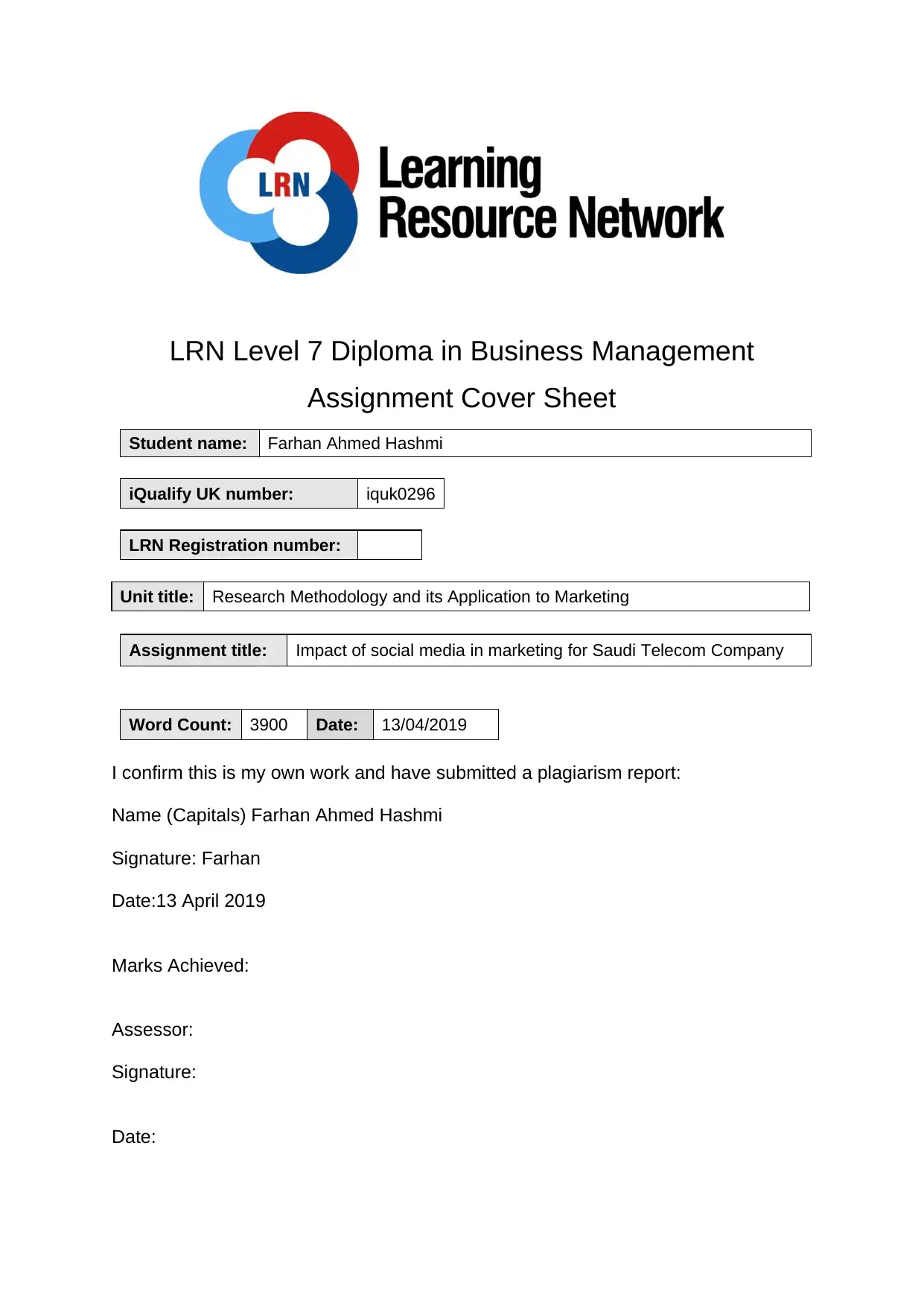
LRN Level 7 Diploma in Business Management
Assignment Cover Sheet
Student name: Farhan Ahmed Hashmi
iQualify UK number: iquk0296
LRN Registration number:
Unit title: Research Methodology and its Application to Marketing
Assignment title: Impact of social media in marketing for Saudi Telecom Company
Word Count: 3900 Date: 13/04/2019
I confirm this is my own work and have submitted a plagiarism report:
Name (Capitals) Farhan Ahmed Hashmi
Signature: Farhan
Date:13 April 2019
Marks Achieved:
Assessor:
Signature:
Date:
Assignment Cover Sheet
Student name: Farhan Ahmed Hashmi
iQualify UK number: iquk0296
LRN Registration number:
Unit title: Research Methodology and its Application to Marketing
Assignment title: Impact of social media in marketing for Saudi Telecom Company
Word Count: 3900 Date: 13/04/2019
I confirm this is my own work and have submitted a plagiarism report:
Name (Capitals) Farhan Ahmed Hashmi
Signature: Farhan
Date:13 April 2019
Marks Achieved:
Assessor:
Signature:
Date:
Paraphrase This Document
Need a fresh take? Get an instant paraphrase of this document with our AI Paraphraser
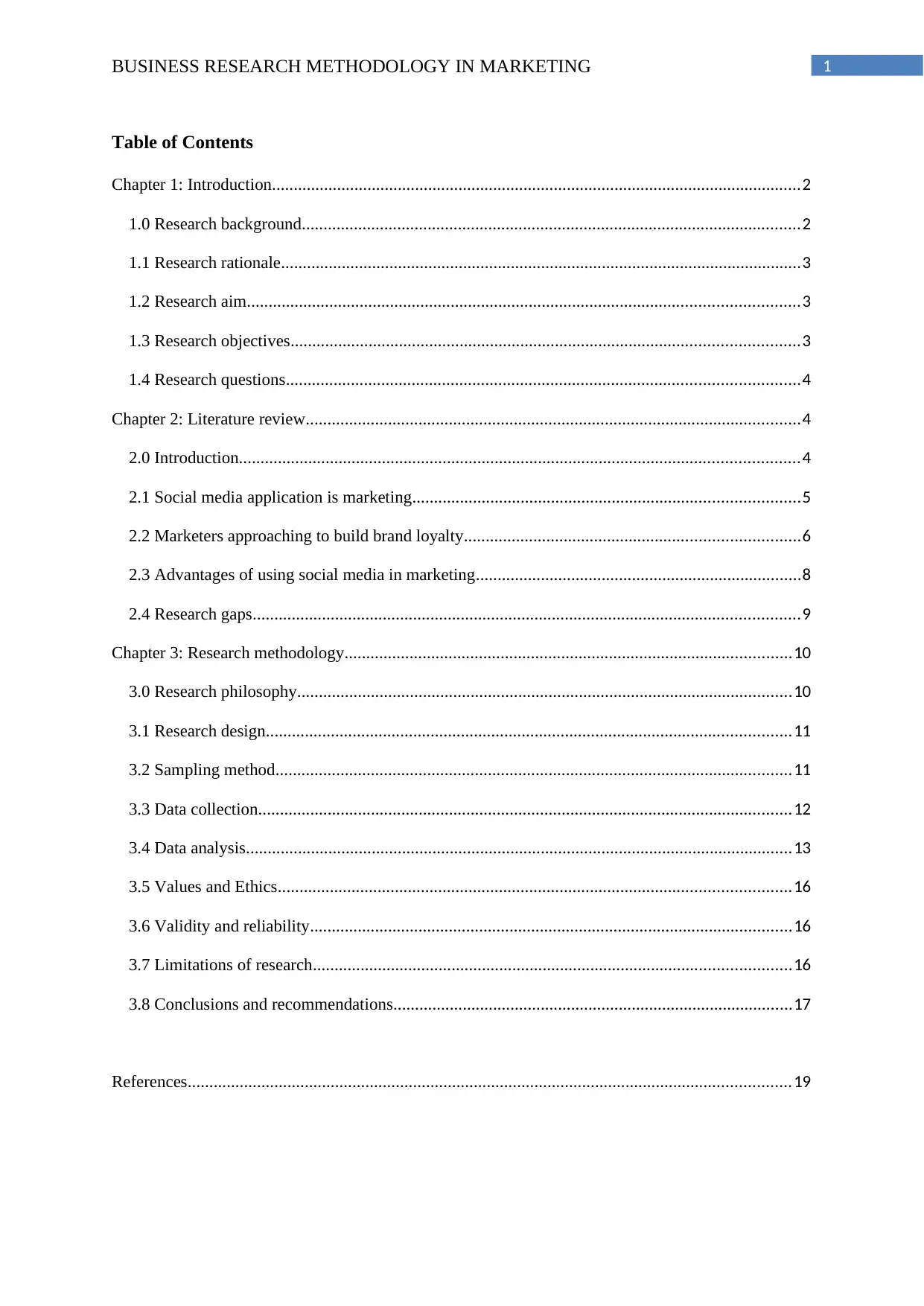
1BUSINESS RESEARCH METHODOLOGY IN MARKETING
Table of Contents
Chapter 1: Introduction..........................................................................................................................2
1.0 Research background...................................................................................................................2
1.1 Research rationale........................................................................................................................3
1.2 Research aim...............................................................................................................................3
1.3 Research objectives.....................................................................................................................3
1.4 Research questions......................................................................................................................4
Chapter 2: Literature review..................................................................................................................4
2.0 Introduction.................................................................................................................................4
2.1 Social media application is marketing.........................................................................................5
2.2 Marketers approaching to build brand loyalty.............................................................................6
2.3 Advantages of using social media in marketing...........................................................................8
2.4 Research gaps..............................................................................................................................9
Chapter 3: Research methodology.......................................................................................................10
3.0 Research philosophy..................................................................................................................10
3.1 Research design.........................................................................................................................11
3.2 Sampling method.......................................................................................................................11
3.3 Data collection...........................................................................................................................12
3.4 Data analysis..............................................................................................................................13
3.5 Values and Ethics......................................................................................................................16
3.6 Validity and reliability...............................................................................................................16
3.7 Limitations of research..............................................................................................................16
3.8 Conclusions and recommendations............................................................................................17
References...........................................................................................................................................19
Table of Contents
Chapter 1: Introduction..........................................................................................................................2
1.0 Research background...................................................................................................................2
1.1 Research rationale........................................................................................................................3
1.2 Research aim...............................................................................................................................3
1.3 Research objectives.....................................................................................................................3
1.4 Research questions......................................................................................................................4
Chapter 2: Literature review..................................................................................................................4
2.0 Introduction.................................................................................................................................4
2.1 Social media application is marketing.........................................................................................5
2.2 Marketers approaching to build brand loyalty.............................................................................6
2.3 Advantages of using social media in marketing...........................................................................8
2.4 Research gaps..............................................................................................................................9
Chapter 3: Research methodology.......................................................................................................10
3.0 Research philosophy..................................................................................................................10
3.1 Research design.........................................................................................................................11
3.2 Sampling method.......................................................................................................................11
3.3 Data collection...........................................................................................................................12
3.4 Data analysis..............................................................................................................................13
3.5 Values and Ethics......................................................................................................................16
3.6 Validity and reliability...............................................................................................................16
3.7 Limitations of research..............................................................................................................16
3.8 Conclusions and recommendations............................................................................................17
References...........................................................................................................................................19
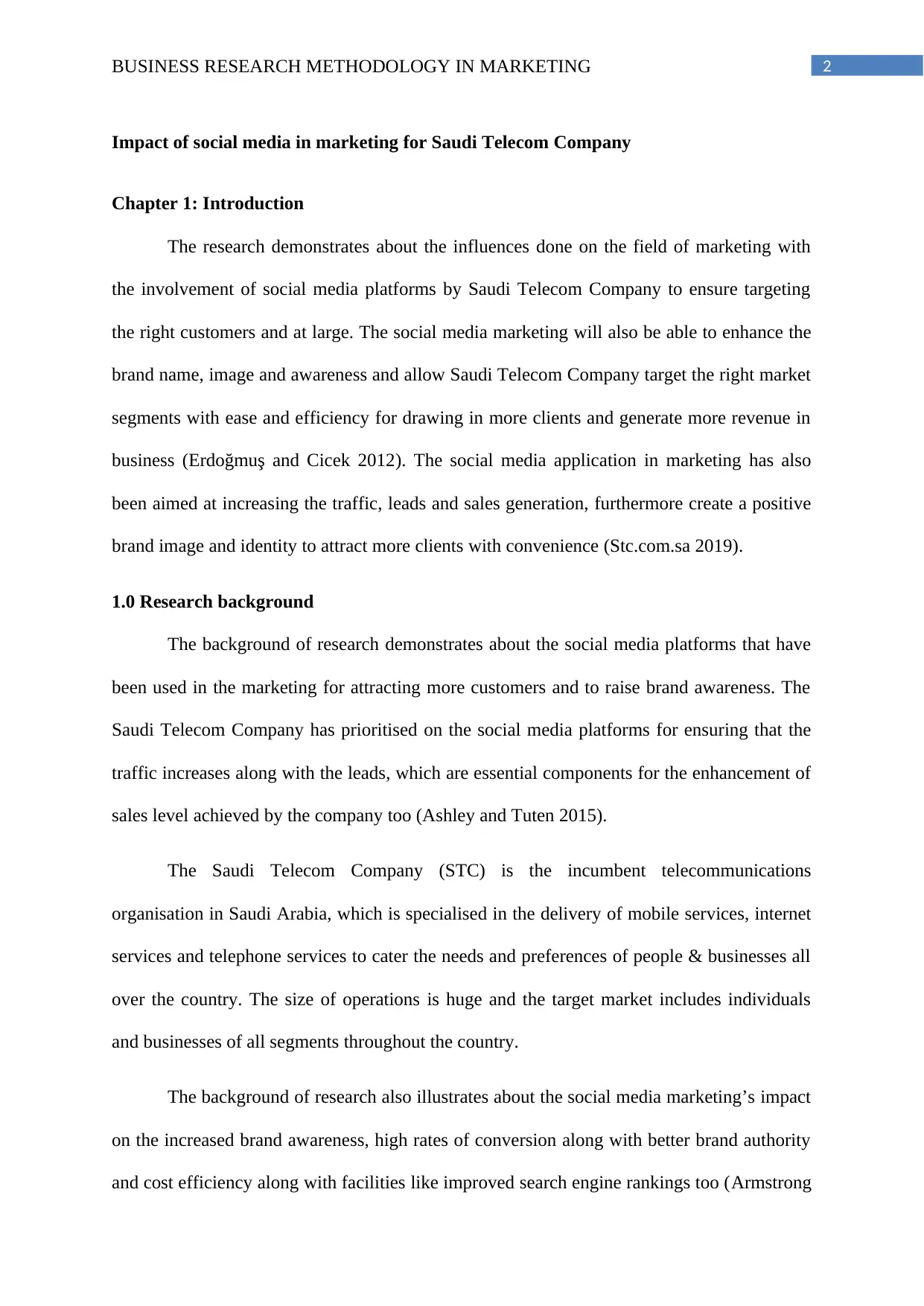
2BUSINESS RESEARCH METHODOLOGY IN MARKETING
Impact of social media in marketing for Saudi Telecom Company
Chapter 1: Introduction
The research demonstrates about the influences done on the field of marketing with
the involvement of social media platforms by Saudi Telecom Company to ensure targeting
the right customers and at large. The social media marketing will also be able to enhance the
brand name, image and awareness and allow Saudi Telecom Company target the right market
segments with ease and efficiency for drawing in more clients and generate more revenue in
business (Erdoğmuş and Cicek 2012). The social media application in marketing has also
been aimed at increasing the traffic, leads and sales generation, furthermore create a positive
brand image and identity to attract more clients with convenience (Stc.com.sa 2019).
1.0 Research background
The background of research demonstrates about the social media platforms that have
been used in the marketing for attracting more customers and to raise brand awareness. The
Saudi Telecom Company has prioritised on the social media platforms for ensuring that the
traffic increases along with the leads, which are essential components for the enhancement of
sales level achieved by the company too (Ashley and Tuten 2015).
The Saudi Telecom Company (STC) is the incumbent telecommunications
organisation in Saudi Arabia, which is specialised in the delivery of mobile services, internet
services and telephone services to cater the needs and preferences of people & businesses all
over the country. The size of operations is huge and the target market includes individuals
and businesses of all segments throughout the country.
The background of research also illustrates about the social media marketing’s impact
on the increased brand awareness, high rates of conversion along with better brand authority
and cost efficiency along with facilities like improved search engine rankings too (Armstrong
Impact of social media in marketing for Saudi Telecom Company
Chapter 1: Introduction
The research demonstrates about the influences done on the field of marketing with
the involvement of social media platforms by Saudi Telecom Company to ensure targeting
the right customers and at large. The social media marketing will also be able to enhance the
brand name, image and awareness and allow Saudi Telecom Company target the right market
segments with ease and efficiency for drawing in more clients and generate more revenue in
business (Erdoğmuş and Cicek 2012). The social media application in marketing has also
been aimed at increasing the traffic, leads and sales generation, furthermore create a positive
brand image and identity to attract more clients with convenience (Stc.com.sa 2019).
1.0 Research background
The background of research demonstrates about the social media platforms that have
been used in the marketing for attracting more customers and to raise brand awareness. The
Saudi Telecom Company has prioritised on the social media platforms for ensuring that the
traffic increases along with the leads, which are essential components for the enhancement of
sales level achieved by the company too (Ashley and Tuten 2015).
The Saudi Telecom Company (STC) is the incumbent telecommunications
organisation in Saudi Arabia, which is specialised in the delivery of mobile services, internet
services and telephone services to cater the needs and preferences of people & businesses all
over the country. The size of operations is huge and the target market includes individuals
and businesses of all segments throughout the country.
The background of research also illustrates about the social media marketing’s impact
on the increased brand awareness, high rates of conversion along with better brand authority
and cost efficiency along with facilities like improved search engine rankings too (Armstrong
⊘ This is a preview!⊘
Do you want full access?
Subscribe today to unlock all pages.

Trusted by 1+ million students worldwide
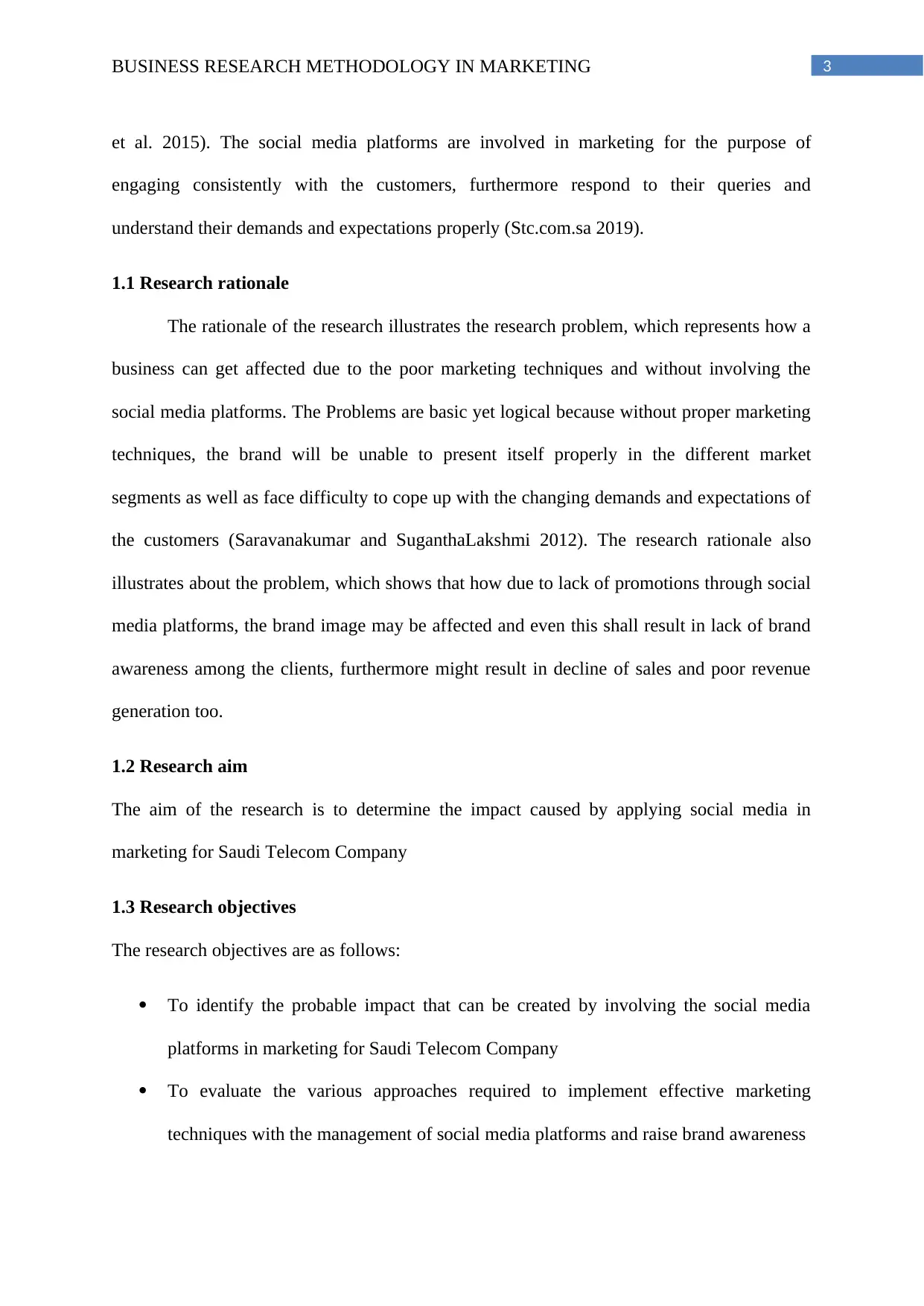
3BUSINESS RESEARCH METHODOLOGY IN MARKETING
et al. 2015). The social media platforms are involved in marketing for the purpose of
engaging consistently with the customers, furthermore respond to their queries and
understand their demands and expectations properly (Stc.com.sa 2019).
1.1 Research rationale
The rationale of the research illustrates the research problem, which represents how a
business can get affected due to the poor marketing techniques and without involving the
social media platforms. The Problems are basic yet logical because without proper marketing
techniques, the brand will be unable to present itself properly in the different market
segments as well as face difficulty to cope up with the changing demands and expectations of
the customers (Saravanakumar and SuganthaLakshmi 2012). The research rationale also
illustrates about the problem, which shows that how due to lack of promotions through social
media platforms, the brand image may be affected and even this shall result in lack of brand
awareness among the clients, furthermore might result in decline of sales and poor revenue
generation too.
1.2 Research aim
The aim of the research is to determine the impact caused by applying social media in
marketing for Saudi Telecom Company
1.3 Research objectives
The research objectives are as follows:
To identify the probable impact that can be created by involving the social media
platforms in marketing for Saudi Telecom Company
To evaluate the various approaches required to implement effective marketing
techniques with the management of social media platforms and raise brand awareness
et al. 2015). The social media platforms are involved in marketing for the purpose of
engaging consistently with the customers, furthermore respond to their queries and
understand their demands and expectations properly (Stc.com.sa 2019).
1.1 Research rationale
The rationale of the research illustrates the research problem, which represents how a
business can get affected due to the poor marketing techniques and without involving the
social media platforms. The Problems are basic yet logical because without proper marketing
techniques, the brand will be unable to present itself properly in the different market
segments as well as face difficulty to cope up with the changing demands and expectations of
the customers (Saravanakumar and SuganthaLakshmi 2012). The research rationale also
illustrates about the problem, which shows that how due to lack of promotions through social
media platforms, the brand image may be affected and even this shall result in lack of brand
awareness among the clients, furthermore might result in decline of sales and poor revenue
generation too.
1.2 Research aim
The aim of the research is to determine the impact caused by applying social media in
marketing for Saudi Telecom Company
1.3 Research objectives
The research objectives are as follows:
To identify the probable impact that can be created by involving the social media
platforms in marketing for Saudi Telecom Company
To evaluate the various approaches required to implement effective marketing
techniques with the management of social media platforms and raise brand awareness
Paraphrase This Document
Need a fresh take? Get an instant paraphrase of this document with our AI Paraphraser
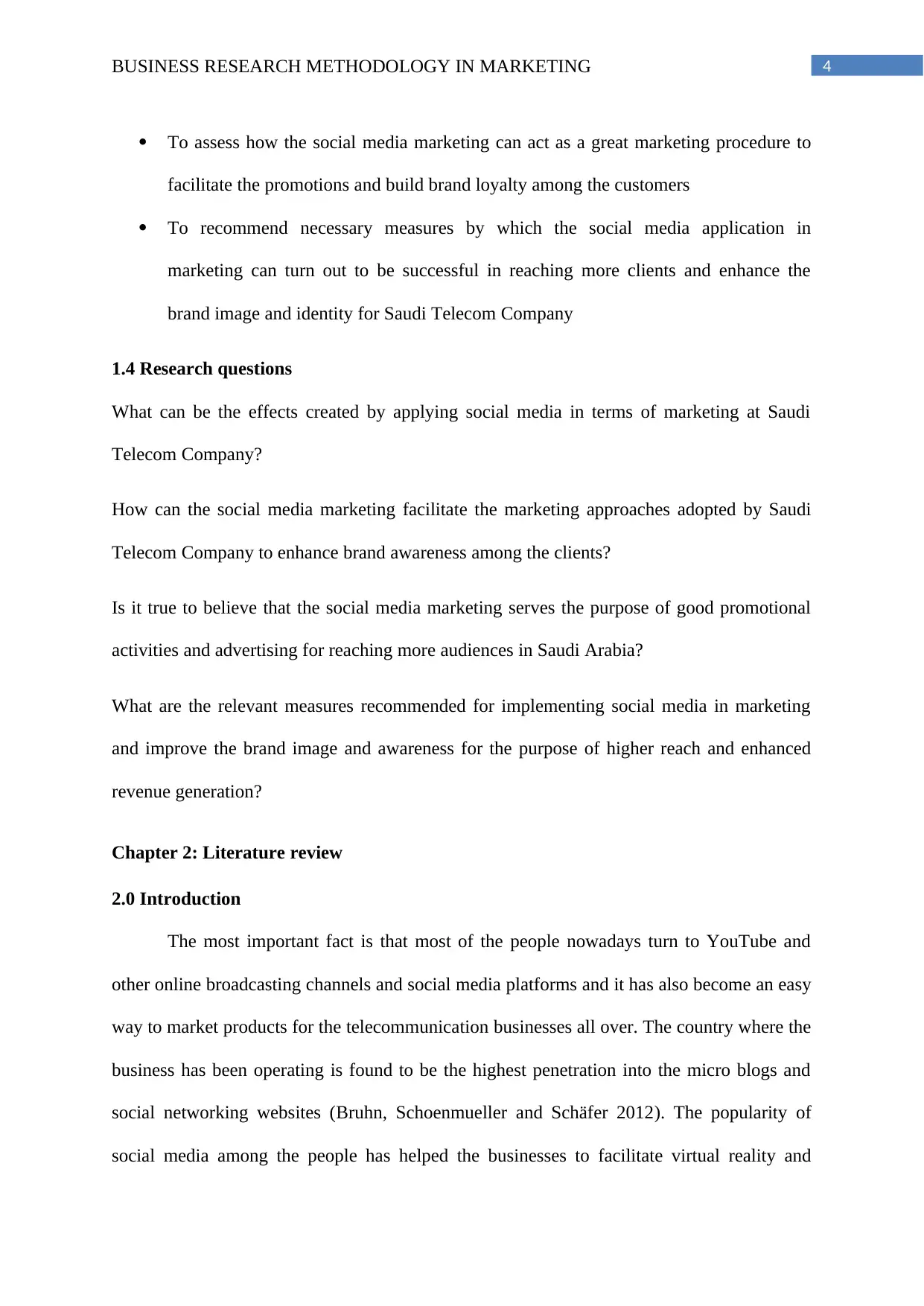
4BUSINESS RESEARCH METHODOLOGY IN MARKETING
To assess how the social media marketing can act as a great marketing procedure to
facilitate the promotions and build brand loyalty among the customers
To recommend necessary measures by which the social media application in
marketing can turn out to be successful in reaching more clients and enhance the
brand image and identity for Saudi Telecom Company
1.4 Research questions
What can be the effects created by applying social media in terms of marketing at Saudi
Telecom Company?
How can the social media marketing facilitate the marketing approaches adopted by Saudi
Telecom Company to enhance brand awareness among the clients?
Is it true to believe that the social media marketing serves the purpose of good promotional
activities and advertising for reaching more audiences in Saudi Arabia?
What are the relevant measures recommended for implementing social media in marketing
and improve the brand image and awareness for the purpose of higher reach and enhanced
revenue generation?
Chapter 2: Literature review
2.0 Introduction
The most important fact is that most of the people nowadays turn to YouTube and
other online broadcasting channels and social media platforms and it has also become an easy
way to market products for the telecommunication businesses all over. The country where the
business has been operating is found to be the highest penetration into the micro blogs and
social networking websites (Bruhn, Schoenmueller and Schäfer 2012). The popularity of
social media among the people has helped the businesses to facilitate virtual reality and
To assess how the social media marketing can act as a great marketing procedure to
facilitate the promotions and build brand loyalty among the customers
To recommend necessary measures by which the social media application in
marketing can turn out to be successful in reaching more clients and enhance the
brand image and identity for Saudi Telecom Company
1.4 Research questions
What can be the effects created by applying social media in terms of marketing at Saudi
Telecom Company?
How can the social media marketing facilitate the marketing approaches adopted by Saudi
Telecom Company to enhance brand awareness among the clients?
Is it true to believe that the social media marketing serves the purpose of good promotional
activities and advertising for reaching more audiences in Saudi Arabia?
What are the relevant measures recommended for implementing social media in marketing
and improve the brand image and awareness for the purpose of higher reach and enhanced
revenue generation?
Chapter 2: Literature review
2.0 Introduction
The most important fact is that most of the people nowadays turn to YouTube and
other online broadcasting channels and social media platforms and it has also become an easy
way to market products for the telecommunication businesses all over. The country where the
business has been operating is found to be the highest penetration into the micro blogs and
social networking websites (Bruhn, Schoenmueller and Schäfer 2012). The popularity of
social media among the people has helped the businesses to facilitate virtual reality and
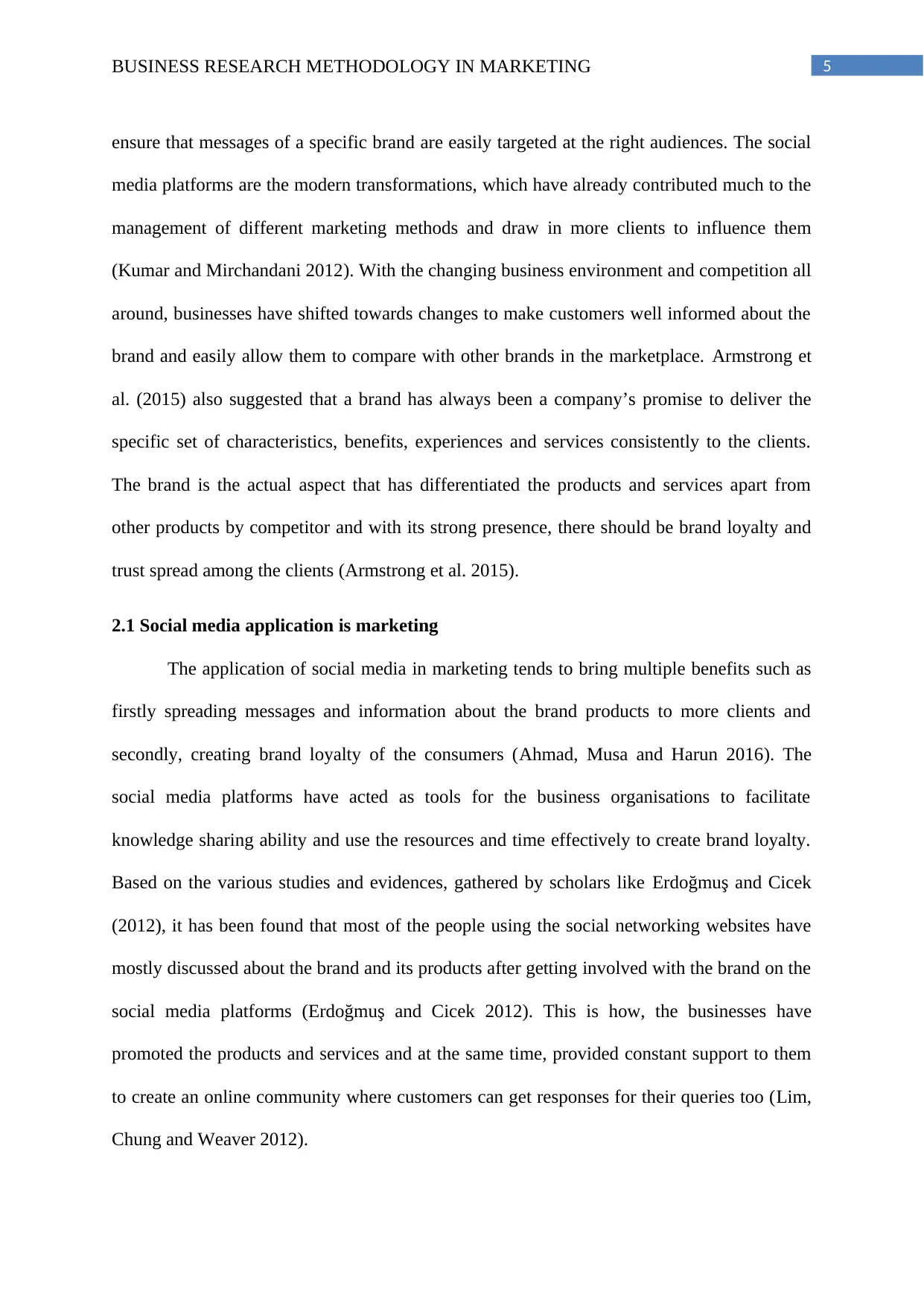
5BUSINESS RESEARCH METHODOLOGY IN MARKETING
ensure that messages of a specific brand are easily targeted at the right audiences. The social
media platforms are the modern transformations, which have already contributed much to the
management of different marketing methods and draw in more clients to influence them
(Kumar and Mirchandani 2012). With the changing business environment and competition all
around, businesses have shifted towards changes to make customers well informed about the
brand and easily allow them to compare with other brands in the marketplace. Armstrong et
al. (2015) also suggested that a brand has always been a company’s promise to deliver the
specific set of characteristics, benefits, experiences and services consistently to the clients.
The brand is the actual aspect that has differentiated the products and services apart from
other products by competitor and with its strong presence, there should be brand loyalty and
trust spread among the clients (Armstrong et al. 2015).
2.1 Social media application is marketing
The application of social media in marketing tends to bring multiple benefits such as
firstly spreading messages and information about the brand products to more clients and
secondly, creating brand loyalty of the consumers (Ahmad, Musa and Harun 2016). The
social media platforms have acted as tools for the business organisations to facilitate
knowledge sharing ability and use the resources and time effectively to create brand loyalty.
Based on the various studies and evidences, gathered by scholars like Erdoğmuş and Cicek
(2012), it has been found that most of the people using the social networking websites have
mostly discussed about the brand and its products after getting involved with the brand on the
social media platforms (Erdoğmuş and Cicek 2012). This is how, the businesses have
promoted the products and services and at the same time, provided constant support to them
to create an online community where customers can get responses for their queries too (Lim,
Chung and Weaver 2012).
ensure that messages of a specific brand are easily targeted at the right audiences. The social
media platforms are the modern transformations, which have already contributed much to the
management of different marketing methods and draw in more clients to influence them
(Kumar and Mirchandani 2012). With the changing business environment and competition all
around, businesses have shifted towards changes to make customers well informed about the
brand and easily allow them to compare with other brands in the marketplace. Armstrong et
al. (2015) also suggested that a brand has always been a company’s promise to deliver the
specific set of characteristics, benefits, experiences and services consistently to the clients.
The brand is the actual aspect that has differentiated the products and services apart from
other products by competitor and with its strong presence, there should be brand loyalty and
trust spread among the clients (Armstrong et al. 2015).
2.1 Social media application is marketing
The application of social media in marketing tends to bring multiple benefits such as
firstly spreading messages and information about the brand products to more clients and
secondly, creating brand loyalty of the consumers (Ahmad, Musa and Harun 2016). The
social media platforms have acted as tools for the business organisations to facilitate
knowledge sharing ability and use the resources and time effectively to create brand loyalty.
Based on the various studies and evidences, gathered by scholars like Erdoğmuş and Cicek
(2012), it has been found that most of the people using the social networking websites have
mostly discussed about the brand and its products after getting involved with the brand on the
social media platforms (Erdoğmuş and Cicek 2012). This is how, the businesses have
promoted the products and services and at the same time, provided constant support to them
to create an online community where customers can get responses for their queries too (Lim,
Chung and Weaver 2012).
⊘ This is a preview!⊘
Do you want full access?
Subscribe today to unlock all pages.

Trusted by 1+ million students worldwide
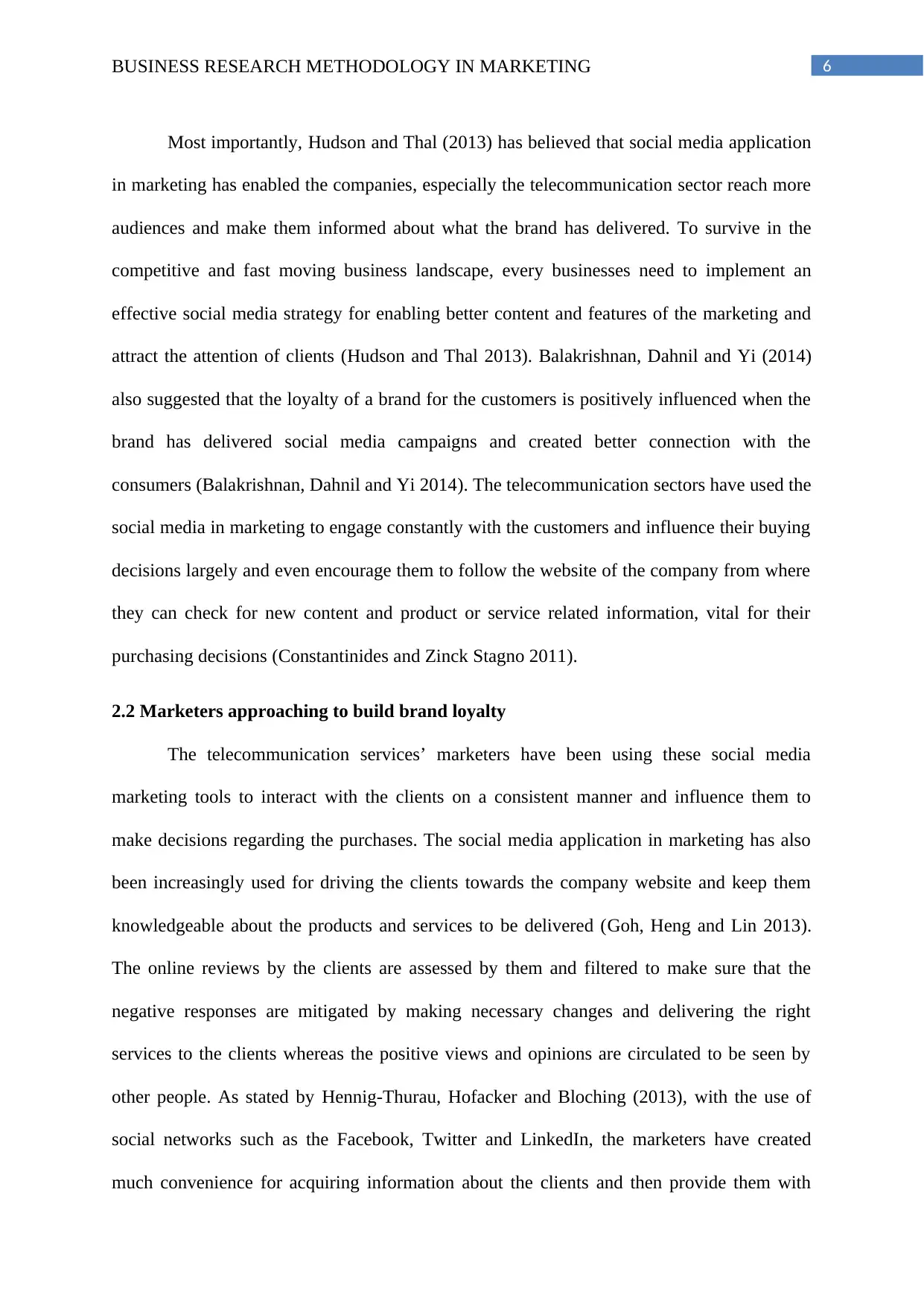
6BUSINESS RESEARCH METHODOLOGY IN MARKETING
Most importantly, Hudson and Thal (2013) has believed that social media application
in marketing has enabled the companies, especially the telecommunication sector reach more
audiences and make them informed about what the brand has delivered. To survive in the
competitive and fast moving business landscape, every businesses need to implement an
effective social media strategy for enabling better content and features of the marketing and
attract the attention of clients (Hudson and Thal 2013). Balakrishnan, Dahnil and Yi (2014)
also suggested that the loyalty of a brand for the customers is positively influenced when the
brand has delivered social media campaigns and created better connection with the
consumers (Balakrishnan, Dahnil and Yi 2014). The telecommunication sectors have used the
social media in marketing to engage constantly with the customers and influence their buying
decisions largely and even encourage them to follow the website of the company from where
they can check for new content and product or service related information, vital for their
purchasing decisions (Constantinides and Zinck Stagno 2011).
2.2 Marketers approaching to build brand loyalty
The telecommunication services’ marketers have been using these social media
marketing tools to interact with the clients on a consistent manner and influence them to
make decisions regarding the purchases. The social media application in marketing has also
been increasingly used for driving the clients towards the company website and keep them
knowledgeable about the products and services to be delivered (Goh, Heng and Lin 2013).
The online reviews by the clients are assessed by them and filtered to make sure that the
negative responses are mitigated by making necessary changes and delivering the right
services to the clients whereas the positive views and opinions are circulated to be seen by
other people. As stated by Hennig-Thurau, Hofacker and Bloching (2013), with the use of
social networks such as the Facebook, Twitter and LinkedIn, the marketers have created
much convenience for acquiring information about the clients and then provide them with
Most importantly, Hudson and Thal (2013) has believed that social media application
in marketing has enabled the companies, especially the telecommunication sector reach more
audiences and make them informed about what the brand has delivered. To survive in the
competitive and fast moving business landscape, every businesses need to implement an
effective social media strategy for enabling better content and features of the marketing and
attract the attention of clients (Hudson and Thal 2013). Balakrishnan, Dahnil and Yi (2014)
also suggested that the loyalty of a brand for the customers is positively influenced when the
brand has delivered social media campaigns and created better connection with the
consumers (Balakrishnan, Dahnil and Yi 2014). The telecommunication sectors have used the
social media in marketing to engage constantly with the customers and influence their buying
decisions largely and even encourage them to follow the website of the company from where
they can check for new content and product or service related information, vital for their
purchasing decisions (Constantinides and Zinck Stagno 2011).
2.2 Marketers approaching to build brand loyalty
The telecommunication services’ marketers have been using these social media
marketing tools to interact with the clients on a consistent manner and influence them to
make decisions regarding the purchases. The social media application in marketing has also
been increasingly used for driving the clients towards the company website and keep them
knowledgeable about the products and services to be delivered (Goh, Heng and Lin 2013).
The online reviews by the clients are assessed by them and filtered to make sure that the
negative responses are mitigated by making necessary changes and delivering the right
services to the clients whereas the positive views and opinions are circulated to be seen by
other people. As stated by Hennig-Thurau, Hofacker and Bloching (2013), with the use of
social networks such as the Facebook, Twitter and LinkedIn, the marketers have created
much convenience for acquiring information about the clients and then provide them with
Paraphrase This Document
Need a fresh take? Get an instant paraphrase of this document with our AI Paraphraser
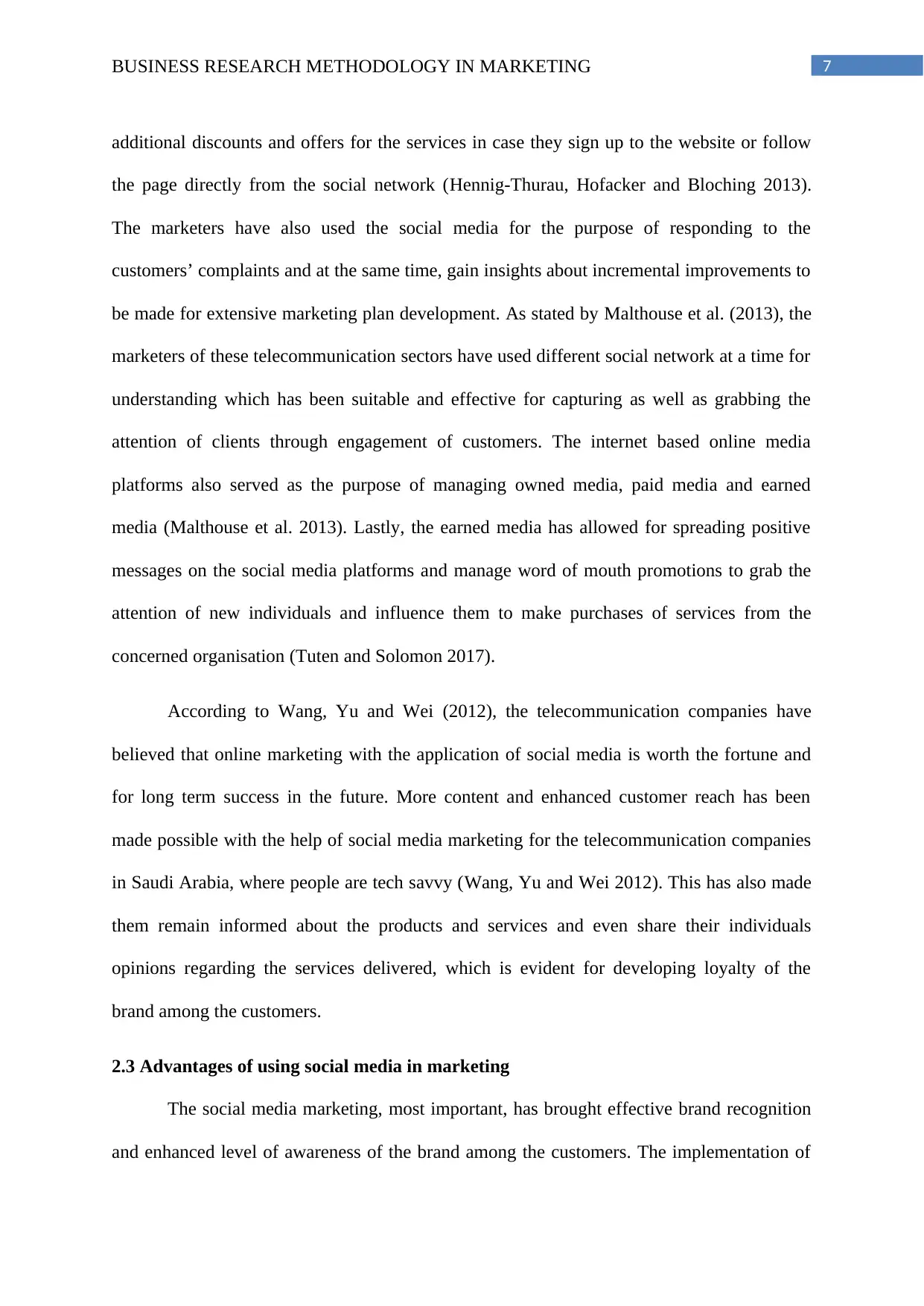
7BUSINESS RESEARCH METHODOLOGY IN MARKETING
additional discounts and offers for the services in case they sign up to the website or follow
the page directly from the social network (Hennig-Thurau, Hofacker and Bloching 2013).
The marketers have also used the social media for the purpose of responding to the
customers’ complaints and at the same time, gain insights about incremental improvements to
be made for extensive marketing plan development. As stated by Malthouse et al. (2013), the
marketers of these telecommunication sectors have used different social network at a time for
understanding which has been suitable and effective for capturing as well as grabbing the
attention of clients through engagement of customers. The internet based online media
platforms also served as the purpose of managing owned media, paid media and earned
media (Malthouse et al. 2013). Lastly, the earned media has allowed for spreading positive
messages on the social media platforms and manage word of mouth promotions to grab the
attention of new individuals and influence them to make purchases of services from the
concerned organisation (Tuten and Solomon 2017).
According to Wang, Yu and Wei (2012), the telecommunication companies have
believed that online marketing with the application of social media is worth the fortune and
for long term success in the future. More content and enhanced customer reach has been
made possible with the help of social media marketing for the telecommunication companies
in Saudi Arabia, where people are tech savvy (Wang, Yu and Wei 2012). This has also made
them remain informed about the products and services and even share their individuals
opinions regarding the services delivered, which is evident for developing loyalty of the
brand among the customers.
2.3 Advantages of using social media in marketing
The social media marketing, most important, has brought effective brand recognition
and enhanced level of awareness of the brand among the customers. The implementation of
additional discounts and offers for the services in case they sign up to the website or follow
the page directly from the social network (Hennig-Thurau, Hofacker and Bloching 2013).
The marketers have also used the social media for the purpose of responding to the
customers’ complaints and at the same time, gain insights about incremental improvements to
be made for extensive marketing plan development. As stated by Malthouse et al. (2013), the
marketers of these telecommunication sectors have used different social network at a time for
understanding which has been suitable and effective for capturing as well as grabbing the
attention of clients through engagement of customers. The internet based online media
platforms also served as the purpose of managing owned media, paid media and earned
media (Malthouse et al. 2013). Lastly, the earned media has allowed for spreading positive
messages on the social media platforms and manage word of mouth promotions to grab the
attention of new individuals and influence them to make purchases of services from the
concerned organisation (Tuten and Solomon 2017).
According to Wang, Yu and Wei (2012), the telecommunication companies have
believed that online marketing with the application of social media is worth the fortune and
for long term success in the future. More content and enhanced customer reach has been
made possible with the help of social media marketing for the telecommunication companies
in Saudi Arabia, where people are tech savvy (Wang, Yu and Wei 2012). This has also made
them remain informed about the products and services and even share their individuals
opinions regarding the services delivered, which is evident for developing loyalty of the
brand among the customers.
2.3 Advantages of using social media in marketing
The social media marketing, most important, has brought effective brand recognition
and enhanced level of awareness of the brand among the customers. The implementation of
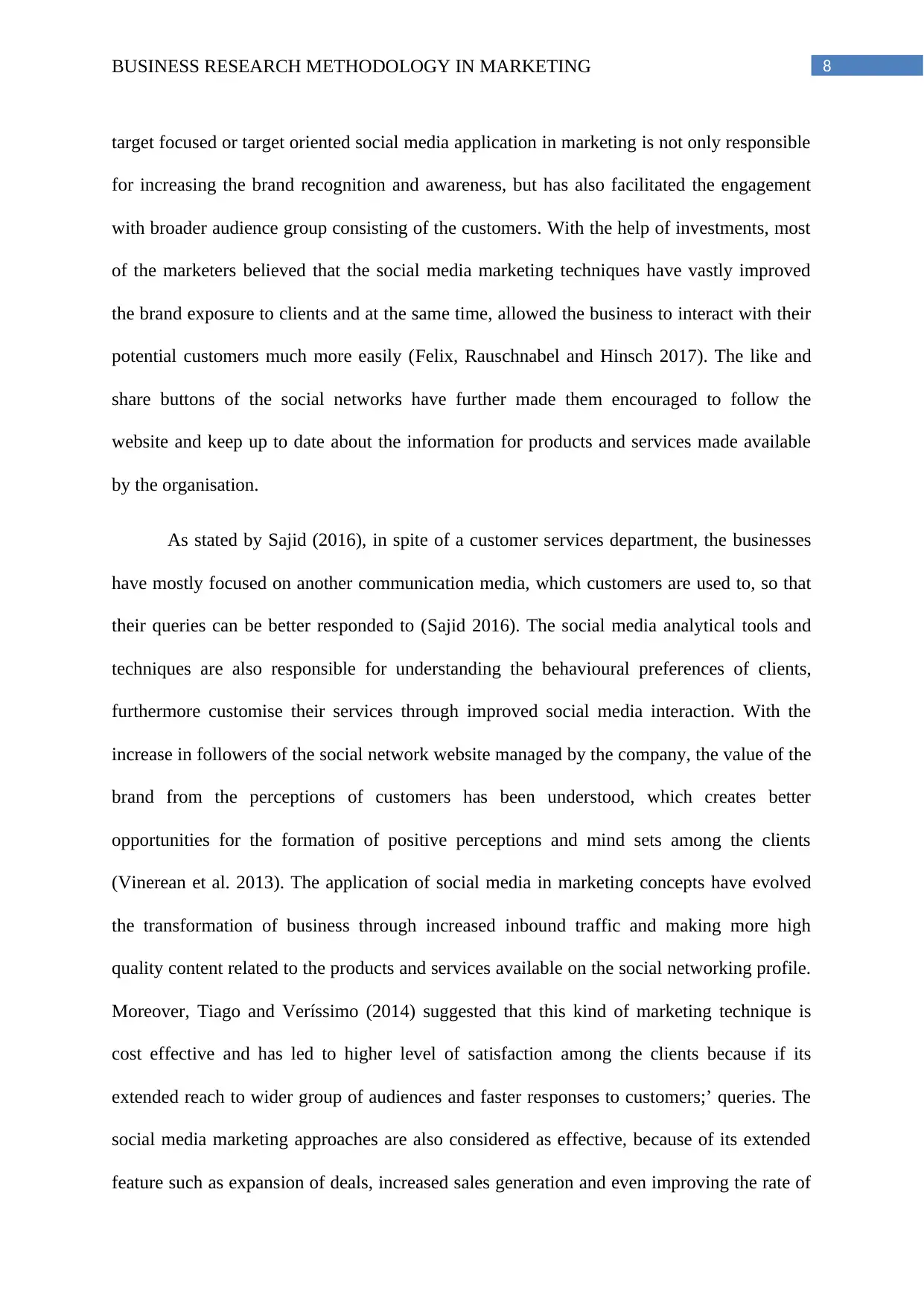
8BUSINESS RESEARCH METHODOLOGY IN MARKETING
target focused or target oriented social media application in marketing is not only responsible
for increasing the brand recognition and awareness, but has also facilitated the engagement
with broader audience group consisting of the customers. With the help of investments, most
of the marketers believed that the social media marketing techniques have vastly improved
the brand exposure to clients and at the same time, allowed the business to interact with their
potential customers much more easily (Felix, Rauschnabel and Hinsch 2017). The like and
share buttons of the social networks have further made them encouraged to follow the
website and keep up to date about the information for products and services made available
by the organisation.
As stated by Sajid (2016), in spite of a customer services department, the businesses
have mostly focused on another communication media, which customers are used to, so that
their queries can be better responded to (Sajid 2016). The social media analytical tools and
techniques are also responsible for understanding the behavioural preferences of clients,
furthermore customise their services through improved social media interaction. With the
increase in followers of the social network website managed by the company, the value of the
brand from the perceptions of customers has been understood, which creates better
opportunities for the formation of positive perceptions and mind sets among the clients
(Vinerean et al. 2013). The application of social media in marketing concepts have evolved
the transformation of business through increased inbound traffic and making more high
quality content related to the products and services available on the social networking profile.
Moreover, Tiago and Veríssimo (2014) suggested that this kind of marketing technique is
cost effective and has led to higher level of satisfaction among the clients because if its
extended reach to wider group of audiences and faster responses to customers;’ queries. The
social media marketing approaches are also considered as effective, because of its extended
feature such as expansion of deals, increased sales generation and even improving the rate of
target focused or target oriented social media application in marketing is not only responsible
for increasing the brand recognition and awareness, but has also facilitated the engagement
with broader audience group consisting of the customers. With the help of investments, most
of the marketers believed that the social media marketing techniques have vastly improved
the brand exposure to clients and at the same time, allowed the business to interact with their
potential customers much more easily (Felix, Rauschnabel and Hinsch 2017). The like and
share buttons of the social networks have further made them encouraged to follow the
website and keep up to date about the information for products and services made available
by the organisation.
As stated by Sajid (2016), in spite of a customer services department, the businesses
have mostly focused on another communication media, which customers are used to, so that
their queries can be better responded to (Sajid 2016). The social media analytical tools and
techniques are also responsible for understanding the behavioural preferences of clients,
furthermore customise their services through improved social media interaction. With the
increase in followers of the social network website managed by the company, the value of the
brand from the perceptions of customers has been understood, which creates better
opportunities for the formation of positive perceptions and mind sets among the clients
(Vinerean et al. 2013). The application of social media in marketing concepts have evolved
the transformation of business through increased inbound traffic and making more high
quality content related to the products and services available on the social networking profile.
Moreover, Tiago and Veríssimo (2014) suggested that this kind of marketing technique is
cost effective and has led to higher level of satisfaction among the clients because if its
extended reach to wider group of audiences and faster responses to customers;’ queries. The
social media marketing approaches are also considered as effective, because of its extended
feature such as expansion of deals, increased sales generation and even improving the rate of
⊘ This is a preview!⊘
Do you want full access?
Subscribe today to unlock all pages.

Trusted by 1+ million students worldwide
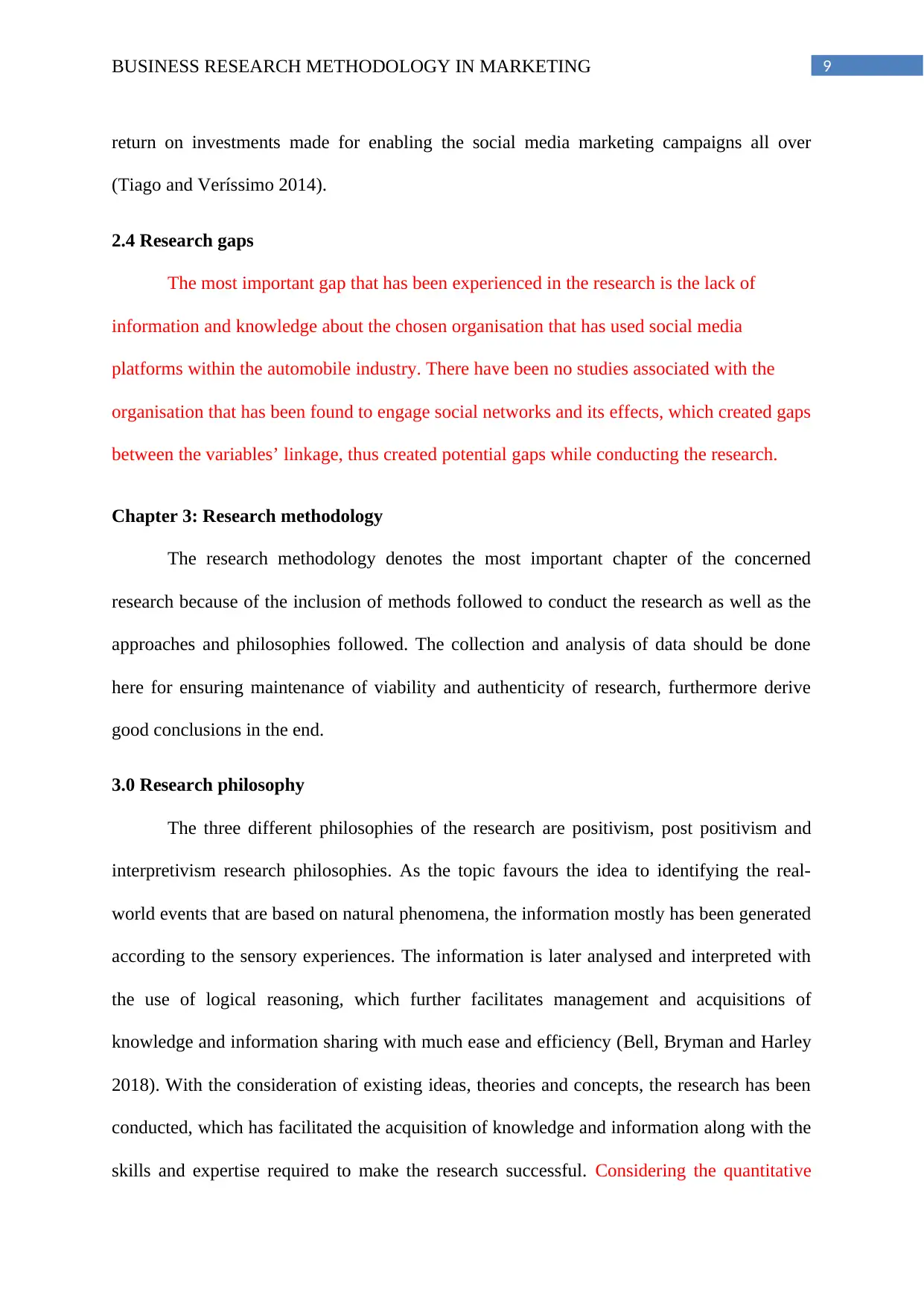
9BUSINESS RESEARCH METHODOLOGY IN MARKETING
return on investments made for enabling the social media marketing campaigns all over
(Tiago and Veríssimo 2014).
2.4 Research gaps
The most important gap that has been experienced in the research is the lack of
information and knowledge about the chosen organisation that has used social media
platforms within the automobile industry. There have been no studies associated with the
organisation that has been found to engage social networks and its effects, which created gaps
between the variables’ linkage, thus created potential gaps while conducting the research.
Chapter 3: Research methodology
The research methodology denotes the most important chapter of the concerned
research because of the inclusion of methods followed to conduct the research as well as the
approaches and philosophies followed. The collection and analysis of data should be done
here for ensuring maintenance of viability and authenticity of research, furthermore derive
good conclusions in the end.
3.0 Research philosophy
The three different philosophies of the research are positivism, post positivism and
interpretivism research philosophies. As the topic favours the idea to identifying the real-
world events that are based on natural phenomena, the information mostly has been generated
according to the sensory experiences. The information is later analysed and interpreted with
the use of logical reasoning, which further facilitates management and acquisitions of
knowledge and information sharing with much ease and efficiency (Bell, Bryman and Harley
2018). With the consideration of existing ideas, theories and concepts, the research has been
conducted, which has facilitated the acquisition of knowledge and information along with the
skills and expertise required to make the research successful. Considering the quantitative
return on investments made for enabling the social media marketing campaigns all over
(Tiago and Veríssimo 2014).
2.4 Research gaps
The most important gap that has been experienced in the research is the lack of
information and knowledge about the chosen organisation that has used social media
platforms within the automobile industry. There have been no studies associated with the
organisation that has been found to engage social networks and its effects, which created gaps
between the variables’ linkage, thus created potential gaps while conducting the research.
Chapter 3: Research methodology
The research methodology denotes the most important chapter of the concerned
research because of the inclusion of methods followed to conduct the research as well as the
approaches and philosophies followed. The collection and analysis of data should be done
here for ensuring maintenance of viability and authenticity of research, furthermore derive
good conclusions in the end.
3.0 Research philosophy
The three different philosophies of the research are positivism, post positivism and
interpretivism research philosophies. As the topic favours the idea to identifying the real-
world events that are based on natural phenomena, the information mostly has been generated
according to the sensory experiences. The information is later analysed and interpreted with
the use of logical reasoning, which further facilitates management and acquisitions of
knowledge and information sharing with much ease and efficiency (Bell, Bryman and Harley
2018). With the consideration of existing ideas, theories and concepts, the research has been
conducted, which has facilitated the acquisition of knowledge and information along with the
skills and expertise required to make the research successful. Considering the quantitative
Paraphrase This Document
Need a fresh take? Get an instant paraphrase of this document with our AI Paraphraser
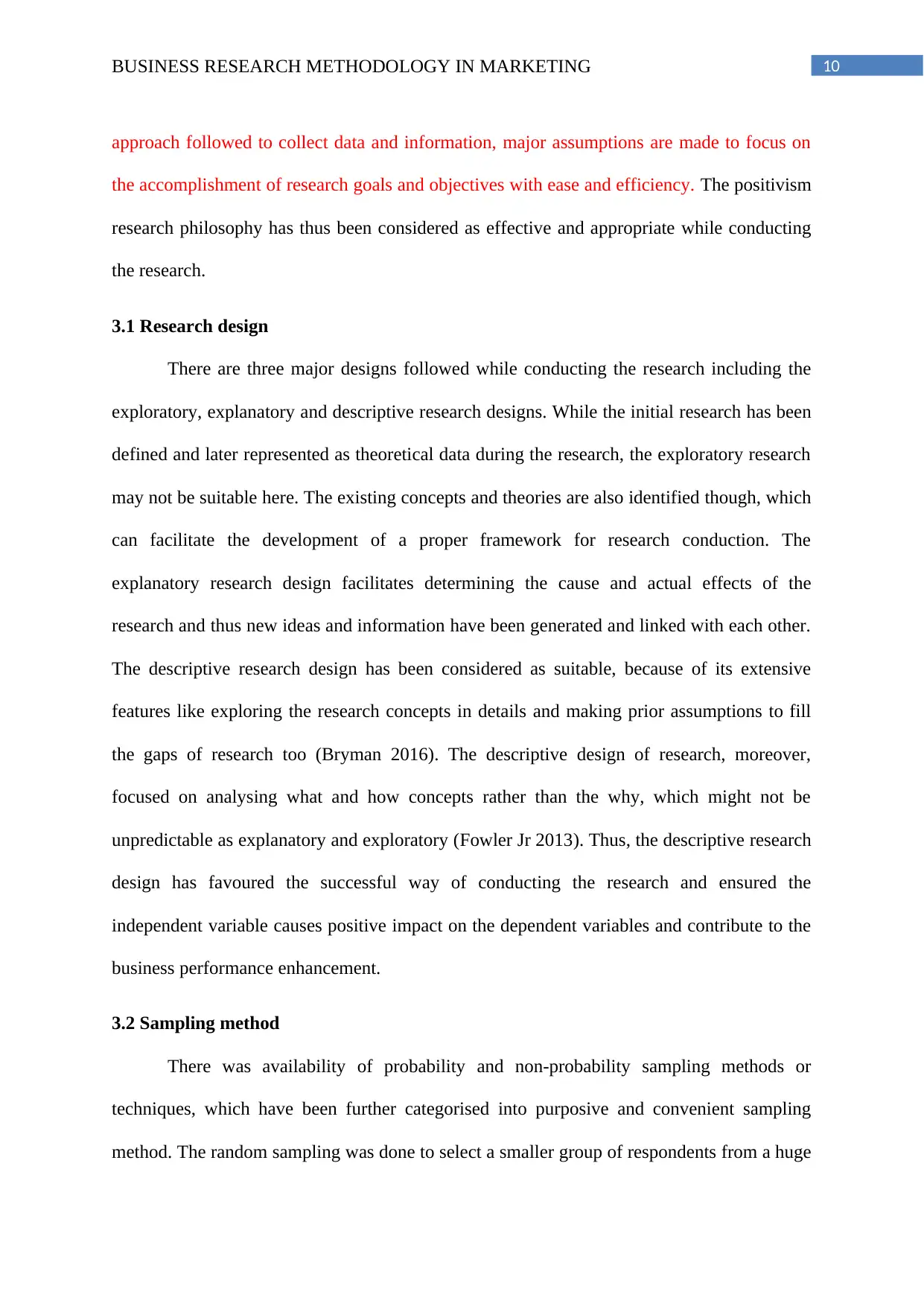
10BUSINESS RESEARCH METHODOLOGY IN MARKETING
approach followed to collect data and information, major assumptions are made to focus on
the accomplishment of research goals and objectives with ease and efficiency. The positivism
research philosophy has thus been considered as effective and appropriate while conducting
the research.
3.1 Research design
There are three major designs followed while conducting the research including the
exploratory, explanatory and descriptive research designs. While the initial research has been
defined and later represented as theoretical data during the research, the exploratory research
may not be suitable here. The existing concepts and theories are also identified though, which
can facilitate the development of a proper framework for research conduction. The
explanatory research design facilitates determining the cause and actual effects of the
research and thus new ideas and information have been generated and linked with each other.
The descriptive research design has been considered as suitable, because of its extensive
features like exploring the research concepts in details and making prior assumptions to fill
the gaps of research too (Bryman 2016). The descriptive design of research, moreover,
focused on analysing what and how concepts rather than the why, which might not be
unpredictable as explanatory and exploratory (Fowler Jr 2013). Thus, the descriptive research
design has favoured the successful way of conducting the research and ensured the
independent variable causes positive impact on the dependent variables and contribute to the
business performance enhancement.
3.2 Sampling method
There was availability of probability and non-probability sampling methods or
techniques, which have been further categorised into purposive and convenient sampling
method. The random sampling was done to select a smaller group of respondents from a huge
approach followed to collect data and information, major assumptions are made to focus on
the accomplishment of research goals and objectives with ease and efficiency. The positivism
research philosophy has thus been considered as effective and appropriate while conducting
the research.
3.1 Research design
There are three major designs followed while conducting the research including the
exploratory, explanatory and descriptive research designs. While the initial research has been
defined and later represented as theoretical data during the research, the exploratory research
may not be suitable here. The existing concepts and theories are also identified though, which
can facilitate the development of a proper framework for research conduction. The
explanatory research design facilitates determining the cause and actual effects of the
research and thus new ideas and information have been generated and linked with each other.
The descriptive research design has been considered as suitable, because of its extensive
features like exploring the research concepts in details and making prior assumptions to fill
the gaps of research too (Bryman 2016). The descriptive design of research, moreover,
focused on analysing what and how concepts rather than the why, which might not be
unpredictable as explanatory and exploratory (Fowler Jr 2013). Thus, the descriptive research
design has favoured the successful way of conducting the research and ensured the
independent variable causes positive impact on the dependent variables and contribute to the
business performance enhancement.
3.2 Sampling method
There was availability of probability and non-probability sampling methods or
techniques, which have been further categorised into purposive and convenient sampling
method. The random sampling was done to select a smaller group of respondents from a huge
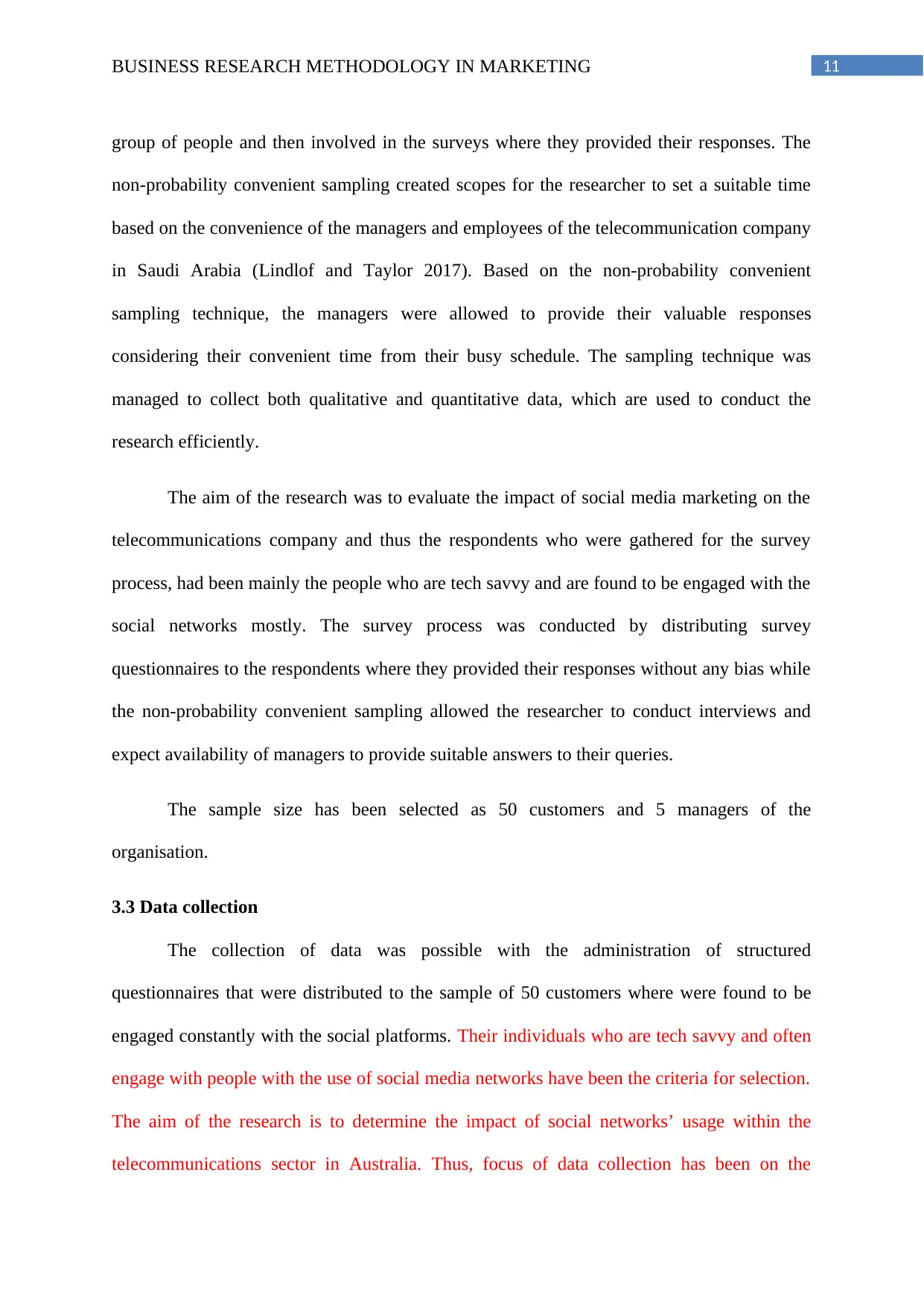
11BUSINESS RESEARCH METHODOLOGY IN MARKETING
group of people and then involved in the surveys where they provided their responses. The
non-probability convenient sampling created scopes for the researcher to set a suitable time
based on the convenience of the managers and employees of the telecommunication company
in Saudi Arabia (Lindlof and Taylor 2017). Based on the non-probability convenient
sampling technique, the managers were allowed to provide their valuable responses
considering their convenient time from their busy schedule. The sampling technique was
managed to collect both qualitative and quantitative data, which are used to conduct the
research efficiently.
The aim of the research was to evaluate the impact of social media marketing on the
telecommunications company and thus the respondents who were gathered for the survey
process, had been mainly the people who are tech savvy and are found to be engaged with the
social networks mostly. The survey process was conducted by distributing survey
questionnaires to the respondents where they provided their responses without any bias while
the non-probability convenient sampling allowed the researcher to conduct interviews and
expect availability of managers to provide suitable answers to their queries.
The sample size has been selected as 50 customers and 5 managers of the
organisation.
3.3 Data collection
The collection of data was possible with the administration of structured
questionnaires that were distributed to the sample of 50 customers where were found to be
engaged constantly with the social platforms. Their individuals who are tech savvy and often
engage with people with the use of social media networks have been the criteria for selection.
The aim of the research is to determine the impact of social networks’ usage within the
telecommunications sector in Australia. Thus, focus of data collection has been on the
group of people and then involved in the surveys where they provided their responses. The
non-probability convenient sampling created scopes for the researcher to set a suitable time
based on the convenience of the managers and employees of the telecommunication company
in Saudi Arabia (Lindlof and Taylor 2017). Based on the non-probability convenient
sampling technique, the managers were allowed to provide their valuable responses
considering their convenient time from their busy schedule. The sampling technique was
managed to collect both qualitative and quantitative data, which are used to conduct the
research efficiently.
The aim of the research was to evaluate the impact of social media marketing on the
telecommunications company and thus the respondents who were gathered for the survey
process, had been mainly the people who are tech savvy and are found to be engaged with the
social networks mostly. The survey process was conducted by distributing survey
questionnaires to the respondents where they provided their responses without any bias while
the non-probability convenient sampling allowed the researcher to conduct interviews and
expect availability of managers to provide suitable answers to their queries.
The sample size has been selected as 50 customers and 5 managers of the
organisation.
3.3 Data collection
The collection of data was possible with the administration of structured
questionnaires that were distributed to the sample of 50 customers where were found to be
engaged constantly with the social platforms. Their individuals who are tech savvy and often
engage with people with the use of social media networks have been the criteria for selection.
The aim of the research is to determine the impact of social networks’ usage within the
telecommunications sector in Australia. Thus, focus of data collection has been on the
⊘ This is a preview!⊘
Do you want full access?
Subscribe today to unlock all pages.

Trusted by 1+ million students worldwide
1 out of 23
Related Documents
Your All-in-One AI-Powered Toolkit for Academic Success.
+13062052269
info@desklib.com
Available 24*7 on WhatsApp / Email
![[object Object]](/_next/static/media/star-bottom.7253800d.svg)
Unlock your academic potential
Copyright © 2020–2025 A2Z Services. All Rights Reserved. Developed and managed by ZUCOL.





